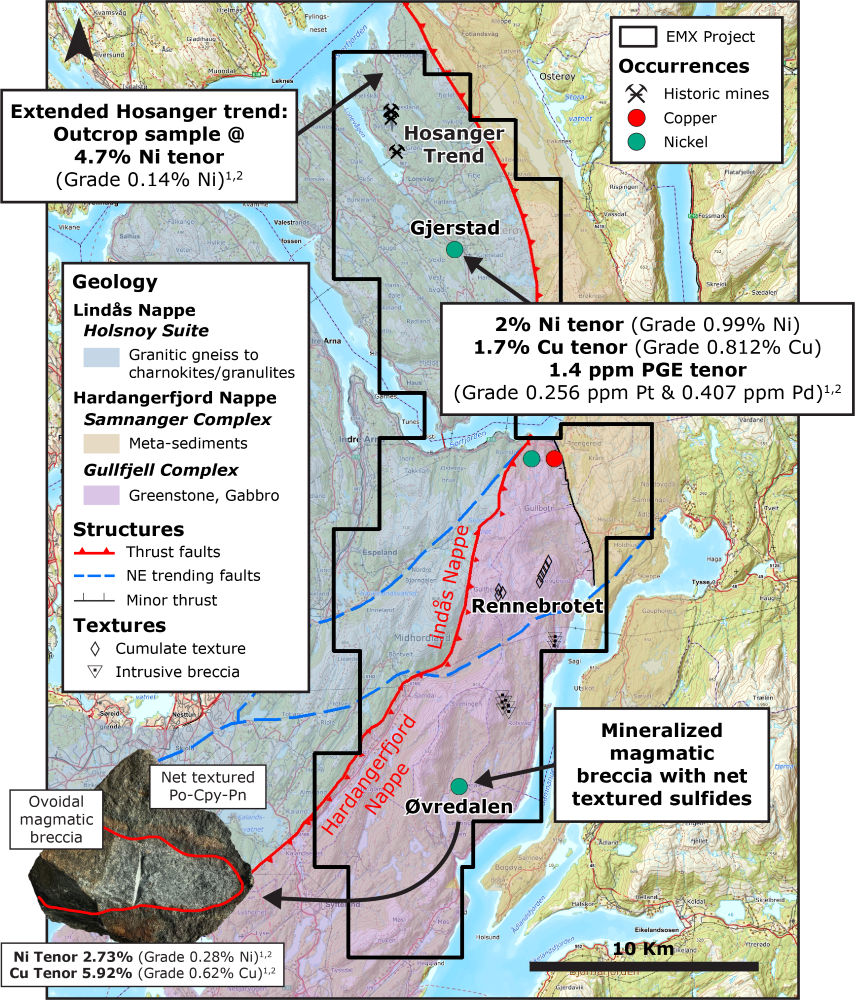Hosanger
EMX’s Hosanger project is located in southern Norway and displays many key characteristics of fertile and productive magmatic systems.
The geology of this region is characterized by a series of nappes that formed during the Caledonian Orogeny (490-390 Ma). The property is comprised of the Hosanger Target Area in the northern half of the license and the Øvredalen Target Area in the south. Historical mines in the Northern Target Area exploited nickel mineralization in the Lindås Nappe periodically between 1875 to 1945 (460,000t @ 1.05% Ni, 0.35% Cu, 0.05% Co)3,4. EMX extended the trend on the mineralization to a 3.5km extent, with possible extension to the south at the Gjerstad occurrence.
The Southern Target Area contains multiple Ni-Cu occurrences listed in the NGU database. Multiple sulfide styles are observed in peridotite rocks from the Øvredalen historical dumps: 1) coarse and disseminated; 2) net-textured; 3) near-massive. Ovoidal magmatic breccia were observed at Øvredalen and Rennebrotet, where barren ultramafic clasts sat in a net-textured sulfide matrix. This suggests a dynamic, high-heat flow environment that saw multiple magma pulses. The presence of net-textured sulfides is indicative of in-situ crystallization from an immiscible sulfide liquid and may indicate proximity to a parent conduit.
Maps
1 EMX rock chip samples are collected in accordance with industry standard best practices. Samples are submitted to ALS in Malå, Sweden where they are prepped before being shipped to ALS in Galway, Ireland for analysis. Accredited control samples (blanks and accredited standards) are inserted into the sample suite regularly. Samples are dried, weighed, crushed (70% < 2mm), and riffle split into two fractions. One is retained (coarse reject) and the other is pulverized to 85% < 75µm. Pulps are analyzed by ultra-trace ICP-MS (ME-MS61) and ICP-AES Au-Pt-Pd (PGM-ICP23). Over detection limit samples are reanalyzed using ore grade ICP-AES by aqua regia (ME-OG62).
2 Tenor was calculated from the multielement geochemistry results from rock chip samples, using the formula: Ni ppm/(S%/35%), where 35% represents an average atomic sulfur content of Ni-Cu-bearing sulfide minerals.
3 Harald Bjorlykke (1949) Hosanger Nikkelgruve, Norges geologiske undersokelse Nr. 172. found at: https://openarchive.ngu.no/ngu-xmlui/bitstream/handle/11250/2674588/NGUnr_172_Bjoerlykke.pdf?sequence=1&isAllowed=y
4 EMX has not performed sufficient work to verify the published drill and resource data. However, the historic drill information as published in various documents available from the NGU (Norwegian Geological Survey) and by Blackstone Ventures are considered relevant.
*Nearby mines and deposits provide context for the project, but do not necessarily indicate similar size, styles or grade of mineralization within the project.

 Click to Enlarge
Click to Enlarge
 Click to Enlarge
Click to Enlarge
 Click to Enlarge
Click to Enlarge
 Click to Enlarge
Click to Enlarge